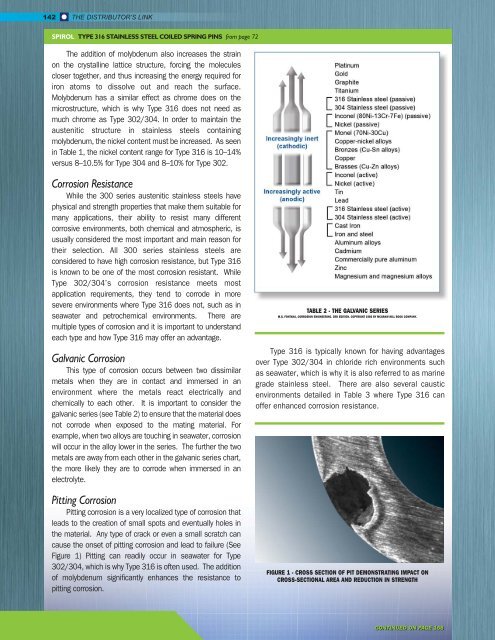WINTER 2016
Distributor's Link Magazine Winter Issue 2016 / Vol 39 No1
Distributor's Link Magazine Winter Issue 2016 / Vol 39 No1
You also want an ePaper? Increase the reach of your titles
YUMPU automatically turns print PDFs into web optimized ePapers that Google loves.
142 THE DISTRIBUTOR’S LINK<br />
SPIROL TYPE 316 STAINLESS STEEL COILED SPRING PINS from page 72<br />
The addition of molybdenum also increases the strain<br />
on the crystalline lattice structure, forcing the molecules<br />
closer together, and thus increasing the energy required for<br />
iron atoms to dissolve out and reach the surface.<br />
Molybdenum has a similar effect as chrome does on the<br />
microstructure, which is why Type 316 does not need as<br />
much chrome as Type 302/304. In order to maintain the<br />
austenitic structure in stainless steels containing<br />
molybdenum, the nickel content must be increased. As seen<br />
in Table 1, the nickel content range for Type 316 is 10–14%<br />
versus 8–10.5% for Type 304 and 8–10% for Type 302.<br />
Corrosion Resistance<br />
While the 300 series austenitic stainless steels have<br />
physical and strength properties that make them suitable for<br />
many applications, their ability to resist many different<br />
corrosive environments, both chemical and atmospheric, is<br />
usually considered the most important and main reason for<br />
their selection. All 300 series stainless steels are<br />
considered to have high corrosion resistance, but Type 316<br />
is known to be one of the most corrosion resistant. While<br />
Type 302/304’s corrosion resistance meets most<br />
application requirements, they tend to corrode in more<br />
severe environments where Type 316 does not, such as in<br />
seawater and petrochemical environments. There are<br />
multiple types of corrosion and it is important to understand<br />
each type and how Type 316 may offer an advantage.<br />
Galvanic Corrosion<br />
This type of corrosion occurs between two dissimilar<br />
metals when they are in contact and immersed in an<br />
environment where the metals react electrically and<br />
chemically to each other. It is important to consider the<br />
galvanic series (see Table 2) to ensure that the material does<br />
not corrode when exposed to the mating material. For<br />
example, when two alloys are touching in seawater, corrosion<br />
will occur in the alloy lower in the series. The further the two<br />
metals are away from each other in the galvanic series chart,<br />
the more likely they are to corrode when immersed in an<br />
electrolyte.<br />
Pitting Corrosion<br />
Pitting corrosion is a very localized type of corrosion that<br />
leads to the creation of small spots and eventually holes in<br />
the material. Any type of crack or even a small scratch can<br />
cause the onset of pitting corrosion and lead to failure (See<br />
Figure 1) Pitting can readily occur in seawater for Type<br />
302/304, which is why Type 316 is often used. The addition<br />
of molybdenum significantly enhances the resistance to<br />
pitting corrosion.<br />
TABLE 2 - THE GALVANIC SERIES<br />
M.G. FONTANA, CORROSION ENGINEERING. 3RD EDITION. COPYRIGHT 1986 BY MCGRAW-HILL BOOK COMPANY.<br />
Type 316 is typically known for having advantages<br />
over Type 302/304 in chloride rich environments such<br />
as seawater, which is why it is also referred to as marine<br />
grade stainless steel. There are also several caustic<br />
environments detailed in Table 3 where Type 316 can<br />
offer enhanced corrosion resistance.<br />
FIGURE 1 - CROSS SECTION OF PIT DEMONSTRATING IMPACT ON<br />
CROSS-SECTIONAL AREA AND REDUCTION IN STRENGTH<br />
CONTINUED ON PAGE 168

















